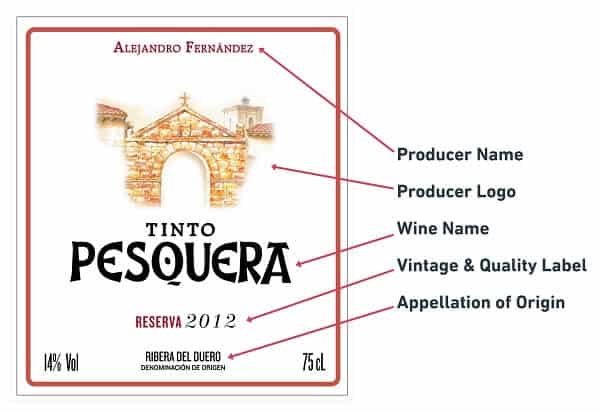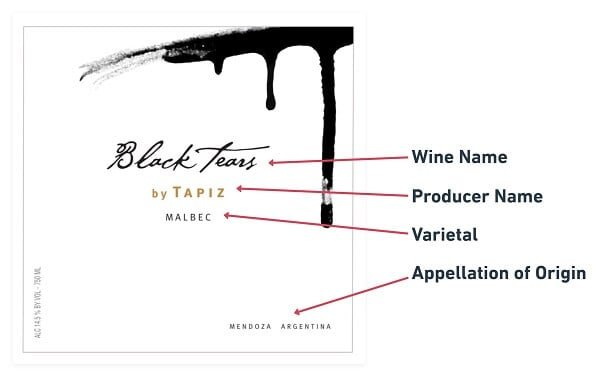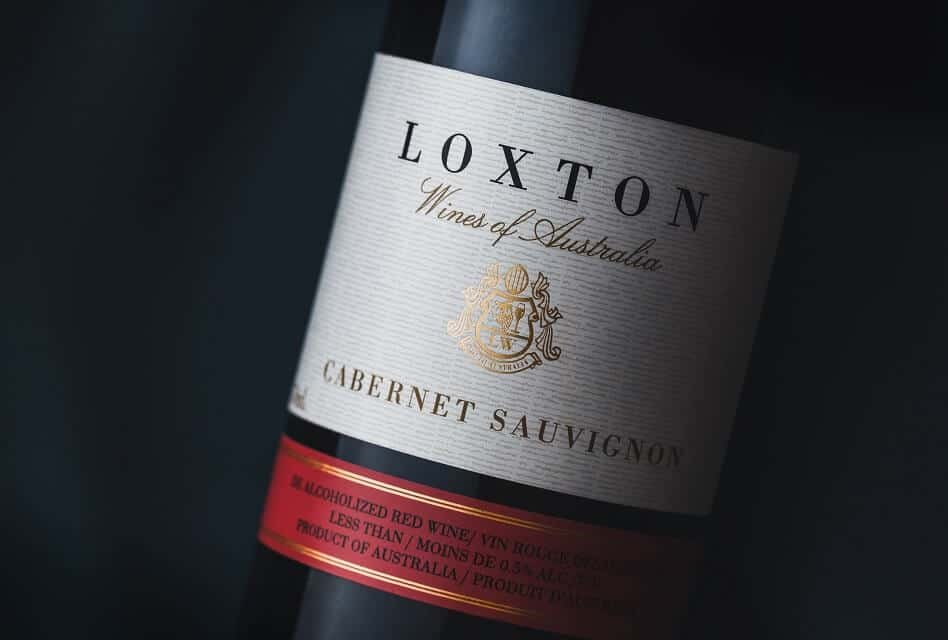Winemaking is a complicated business with many factors that determine a wine’s taste and quality. Its origin, the varietal, the vintage, and other details can tell you a lot about it before drinking it. But to gather this information, you must be able to read a wine bottle label. Unfortunately, this can be difficult because winemakers do not use consistent designs with standardized information across the industry. To identify the essential pieces of information from every design, let’s discuss how to read a wine label.
A wine bottle label is a small piece of paper that a vintner puts on a wine bottle to provide consumers with basic information about its content. It typically contains the wine‘s name, the producer’s name, the appellation of origin, the varietal used to make it, the vintage, information about production methods and the wine style, and the alcohol content.
No matter if you are looking for wine in retail or ordering wine at a restaurant, the ability to read and understand a bottle label is essential to find one that you like. In this article, we will discuss the pieces of information you can find on wine bottle labels and what they mean.
THE HISTORY OF WINE BOTTLE LABELS
Wine labels have a long history that goes back even further than the history of glass bottles. In 1923, Archeologist Howard Carter opened the burial site of Pharaoh Tutankhamun, who ruled Egypt around 1330 BC. In his grave, Carter found wine amphoras made from clay. These amphoras carried hieroglyphs that indicated the vintage of their content. Interestingly, it seemed that only specific vintages were good enough for the last journey of the Pharaoh.
The rulers of the Persian Empire, which was established around 550 BC in Western Asia, were big wine lovers, too. They imported wines from Greece, Phoenicia, and other parts of the Mediterranean area and stored them in the Great King’s wine cellar in the capital Persepolis. Wine labeling became a necessity to keep track of the wines’ origins. And later, other empires adopted this practice.

Image Source: GrapeCollective.com
The first written labels were created in the 17th century. In Medieval Europe, winemaking was in the hand of monasteries. So it is no surprise that the first handwritten wine label on record came from the hand of a monk named Pierre Perignon. If this name sounds familiar to you, it is for a good reason: Dom Perignon developed the Méthode Champenoise, which sparkling wine producers today still follow to make the world-famous Champagne. To honor his achievements, the French winery Moët & Chandon named one of their sparkling wines after him.
With the introduction of glass bottles and a wine trade boom in the 18th century, vintners started to follow the example of Dom Perignon. They wrote information about their wines’ origins and qualities on parchment labels and tied them with strings to the bottlenecks.
In 1798, wine labeling became much easier and less time-consuming. Alois Senefelder, a Czechoslovakian playwright, invented a new printing technique that allowed the affordable and fast mass production of print products, including bottle labels. He called it “stone printing”, but later it became generally known as lithography. Winemakers across Europe used this technique to develop more sophisticated labels. With complex graphics, logos, and colors, they tried to make their wines recognizable and stand out against competitors.
This trend has continued until today. The creativity of winemakers is unlimited when designing their bottle labels, and some even engage professional artists to give their bottles an extraordinary look.
WHAT INFORMATION CAN YOU FIND ON WINE BOTTLE LABELS?
Modern wine labels can contain a lot of different information. Some of them are mandatory by regional law, but others are optional.
The Producer Name
The name of the winery is the element that you can find on almost every wine label. And that makes perfect sense for marketing reasons, as vintners want customers to remember their wines. In many cases, the name is accompanied by a logo or an emblem that represents the company. Wineries with a long tradition often put their founding year on the label, typically above or below their name.
In the United States, the producer name often is the most dominant element of the label. European vintners tend to emphasize other information, such as the appellation of origin.
The Wine Name
Especially in New World wine countries, vintners sometimes give their wines additional brand names. These catchy names help consumers to find their favorite wines again and thus are good marketing tools. Here are some examples:
- Borne of Fire, Carbernet Sauvignon from Washington, U.S.
- Black Tears, Malbec from Argentina
- Flor de Muga, Rosé from the Rioja region in Spain
It is not unusual for New World winemakers to use the winery name synonymously with the wine name, though. So distinguishing the wine name from the producer name can be difficult.
The Appellation of Origin
When reading a wine bottle label from a European wine country such as Italy or France, you will often find the wine’s appellation of origin. The appellation tells you where a wine comes from. Besides, it is also a quality indicator because these appellations are heavily regulated by law. Only vintners that fulfill specific criteria regarding the production process, the ingredients, and the wine quality may put it on their bottles. Local and national authorities control compliance with these rules and test (and taste) the wines’ quality regularly.
Across Europe, you will find thousands of controlled appellations. In France alone, there are more than 450. But there is also a growing number of protected appellations in the United States. However, American regulations in terms of production and ingredients are less strict than in European wine countries.
As it is almost impossible to keep all appellations in mind, vintners typically put an additional term or an abbreviation next to the region name that indicates that the region is a controlled appellation. They vary from country to country, but their purpose is the same. Here are some of them:
- France: Appellation d’Origine Contrôlée (AOC)
- Italy: Denominazione di Origine Controllata (DOC)
- Portugal: Denominação de Origem Controlada (DOC)
- Spain: Denominación de Origen (DO)
- Germany: Qualitätswein bestimmter Anbaugebiete (QbA)
- United States: American Viticultural Area (AVA)
In most countries mentioned above, different quality levels exist. For instance, in Italy, you may find the abbreviation DOCG (Denominazione di Origine Controllata e Garantita), which indicates the highest quality level, instead of DOC, which is the second-highest level.
In addition to the appellation, labels can include a short phrase indicating the country where the wine comes from, such as:
- Prodotto in Italia (Produced in Italy)
- Produit de France (Product of France)
- Producto de España (Product of Spain)
Quality Labels
Winemakers use multiple different terms to indicate their wines’ quality or the production processes they went through. National or regional laws regulate most of these terms. Listing all of these terms would go beyond this article’s scope, so here are only a few examples from different countries:
- Riserva (Italian for “reserve”)
- Grand Cru (French)
- Prädikatswein (German for “superior quality wine”)
- Gran Reserva (Spanish for “grand reserve”)
Style Labels
To give consumers an idea of a wine’s taste, many vintners provide helpful information about its style. This information can include terms that indicate the following characteristics:
- the sweetness or dryness of a wine
- whether it is sparkling, semi-sparkling, or still
- whether the wine was aged in oak or not
The Varietal
The varietal that was used to make the wine is another piece of information that you can find on many bottle labels. Most New World winemakers put it on their bottles to give customers an idea of their wine’s characteristics.
In the Old World, it is rather uncommon to find the varietal name on a wine label. Most European vintners try to create wines that express their region’s terroir instead of the varietal’s characteristics. Thus, they prefer to put the appellation of origin on the label but not the grapes’ name.
In many cases, it is possible to conclude the varietal from the wine’s or region’s name. For instance, Brunello di Montalcino, an Italian red wine from the Tuscany region, is made exclusively from Sangiovese grapes. Another example is red Burgundy from Eastern France. To produce it, Burgundy vintners use only Pinot Noir grapes.
The Vintage
Many winemakers, especially those who produce high-quality wine, print the vintage year on their bottle labels. This date tells you when they harvested the grapes for this wine. The bottling can take place much later, depending on how long the wine aged.
The vintage year can help you to identify a good wine. The reason is the weather: The number of sunny and rainy days, as well as the temperature lows and highs, determine how healthy grapes are and how well they ripen. Thus, a good year in terms of weather results in good wine.
In case the label does not include a vintage, the wine is likely a blend of multiple vintages.
The Alcohol Content
The amount of alcohol that wine contains is a mandatory piece of data in most countries. For example, in the European Union, it must be stated on all bottles, and the authorities check its validity regularly. It might be printed on the back label instead of the front label of the bottle, though. The alcohol content comes as a percentage, typically with “alc.” or “vol.” added before or after it.
Sulfites Content
In some countries, it is also mandatory to mention whether a wine contains sulfites. As people might be sensitive to sulfites, this note helps them to consider their diet more carefully.
HOW TO READ A WINE BOTTLE LABEL
Now that we know the elements of a wine label, let us look at a couple of examples from different countries.
How to Read a Wine Bottle Label from Germany
First, let us discuss how to read a German wine bottle label. Its most prominent element is the name of the winery: “Dönnhoff”. You can also find the winery’s logo and its address. The label clearly states that the varietal Riesling was used to produce this wine and that it comes from the Nahe region, which is one of the 13 controlled wine regions of Germany. Besides, it contains two quality labels:
- “Erzeugerabfüllung” translates to “estate-bottled”. The term indicates that the winery only used grapes from its own estate and did not blend it with grapes from other origins.
- “Qualitätswein” means “Quality Wine” and is a quality label for wines that fulfill specific requirements. They must be produced in one of the official German wine regions and represent this region’s typical characteristics.
Finally, the bottle label contains information about sulfites, the alcohol content, and the quantity.

How to Read a Wine Bottle Label from Italy
The next label from Italy puts the appellation of origin into the center of attention. “Rosso di Montalcino” is a DOC wine, which is the second-highest quality level in Italy.
Wine experts know that Rosso di Montalcino is a dry red wine made from 100% Sangiovese Grosso grapes. So the appellation of origin gives you information about the varietal and the wine’s style and taste.
The number 2017 tells you that the wine is a vintage wine, and all grapes used to make it were harvested in this year.
Besides the appellation of origin and the vintage, the label contains much information about the producer. You can find the name and logo in the top part and the exact geographical details about the vineyards in the bottom part.
Finally, you can find the alcohol content in the left bottom corner and the quantity in the right bottom corner.

How to Read a Wine Bottle Label from France
Our third bottle label is from France, specifically the Haut-Médoc AOC in the Southwestern part of the country. Like in the Italian example, this French appellation tells you something about the wine’s style and the varietals: Haut-Médoc wines are red and can be made from Cabernet Sauvignon, Cabernet Franc, Carménère, Merlot, Malbec, or Petit Verdot.
The vintage of the wine is 2015. The term “Grand Vin” (English: great wine) indicates that only the best grapes from this vintage made it into this wine. Be aware that this term is not regulated. So the wine might be the best from this estate, but it doesn’t have to fulfill any commonly acknowledged quality criteria.
“Château Labet” is the name of the winery. The label shows you its logos (the estate logo on top and the wine logo next to the vintage) and its founding year.

How to Read a Wine Bottle Label from Spain
The next example comes from Spain. The most prominent element on this label is the wine name “Tinto Pesquera”. As the word “Tinto” means “Red” in Spanish, it tells you that it is red wine.
In the top part, you see the producer’s name and the logo of his winery. In the bottom line, you can find the appellation of origin. “Ribera del Duero” is a DO region in Castilla y Leon in Northern Spain. It is famous for high-quality red wines made from Tempranillo grapes.
The vintage of this wine is 2012, and the term “Reserva” (English: Reserve) tells it aged for at least two years with a minimum of one year in oak.

How to Read a Wine Label from the United States
On this label from an American wine, the producer’s name is the biggest element. Together with the winery’s logo, it creates a recognizable branding. Another piece of information about the winery is the founding year in the last line.
You can see one common difference between New World and most Old World wine labels here: They prominently name the varietal, Chardonnay. In contrast, the appellation of origin is printed in rather small letters below the grapes’ name.
The vintage 2018 also has an unobtrusive spot in the top right corner of the label.

How to Read a Wine Label from Argentina
Our last example is an interesting label from the Mendoza province in Western Argentina. As you can see, the appellation of origin is barely readable. It seems that the vintner wants the consumer to focus on other elements.
The most interesting part of the label consists of two parts: The wine name “Black Tears” and the producer name “Tapiz”. They are combined with the word “by” to produce a brand name similar to popular perfumes. Think of “The One by Dolce & Gabbana” or “Eternity by Calvin Klein”.
Like on the American label, you can find the varietal name on this label, too, but it has a rather non-prominent spot.

FINAL WORDS
Be aware that the designs we discussed are only examples. So even within the same country, you can find very different designs. Nevertheless, with the information in this article, you know how to read a wine bottle label and which important you can gather from it.
Recent Posts
Switzerland is famous not only for its beautiful landscapes and its picturesque towns but also for some food items. Especially Swiss cheese and chocolate are world-famous. But do you actually know a...
Winemaking is a sophisticated process that includes multiple steps and can take several years. Depending on the desired wine and the vintner's preferred techniques, these steps can differ. However,...

